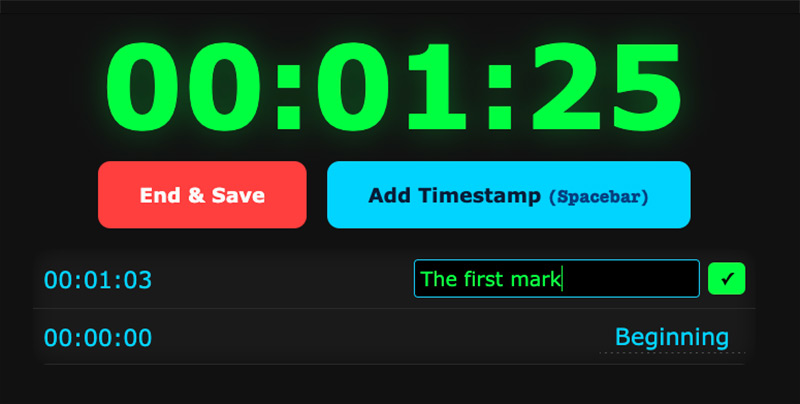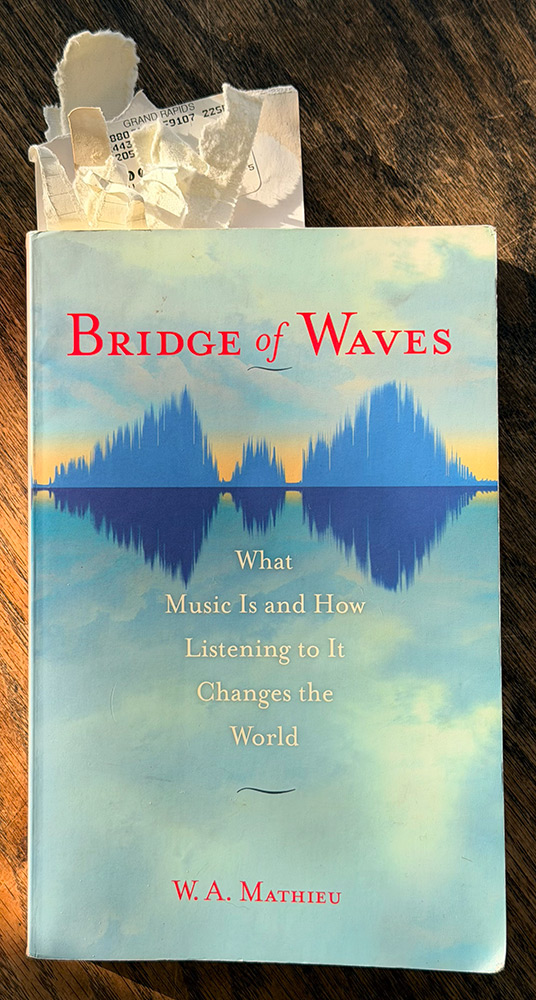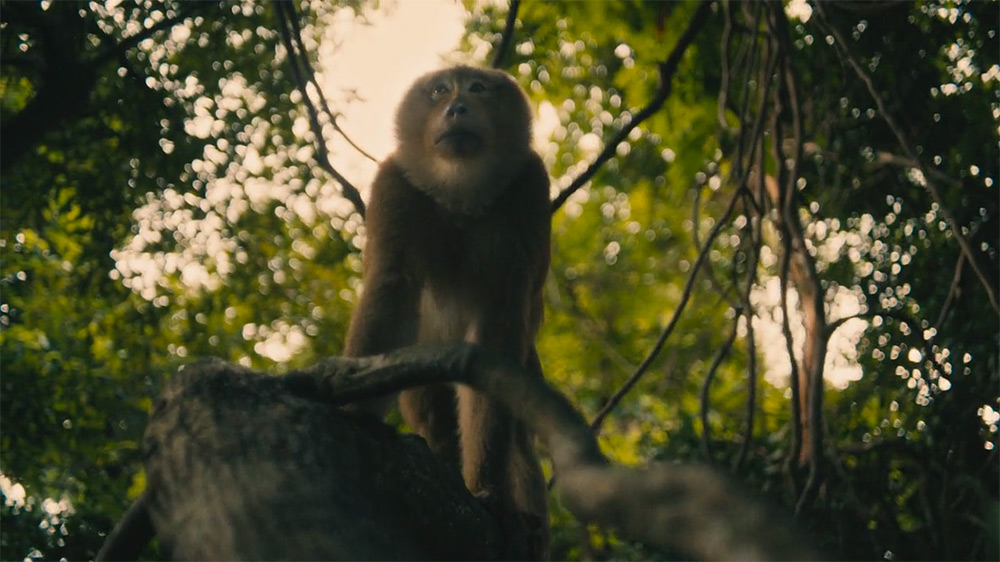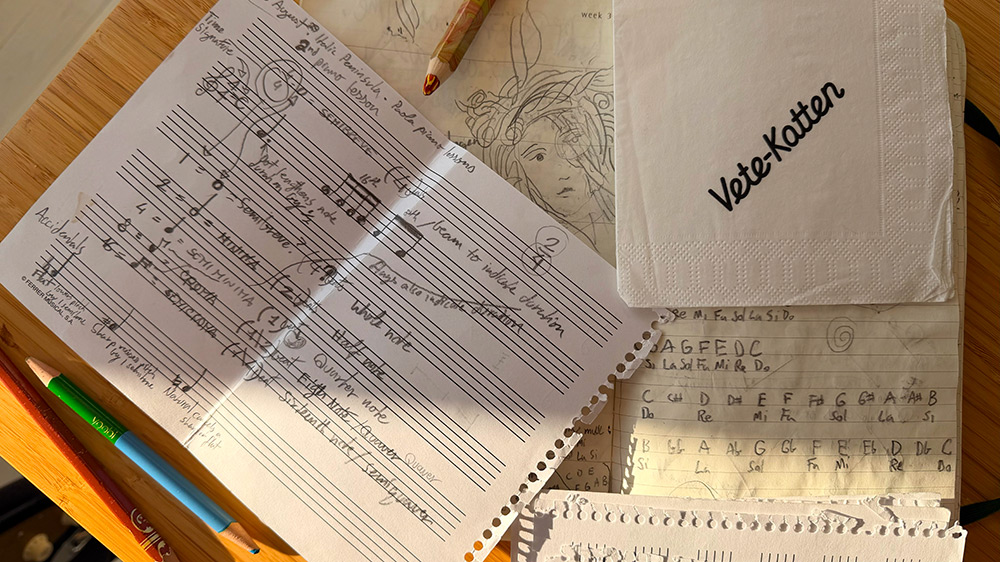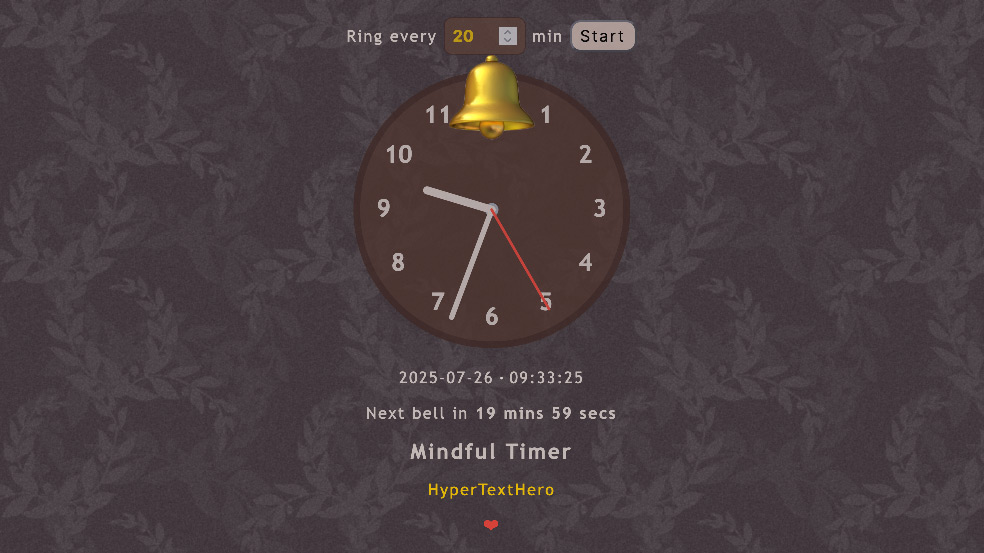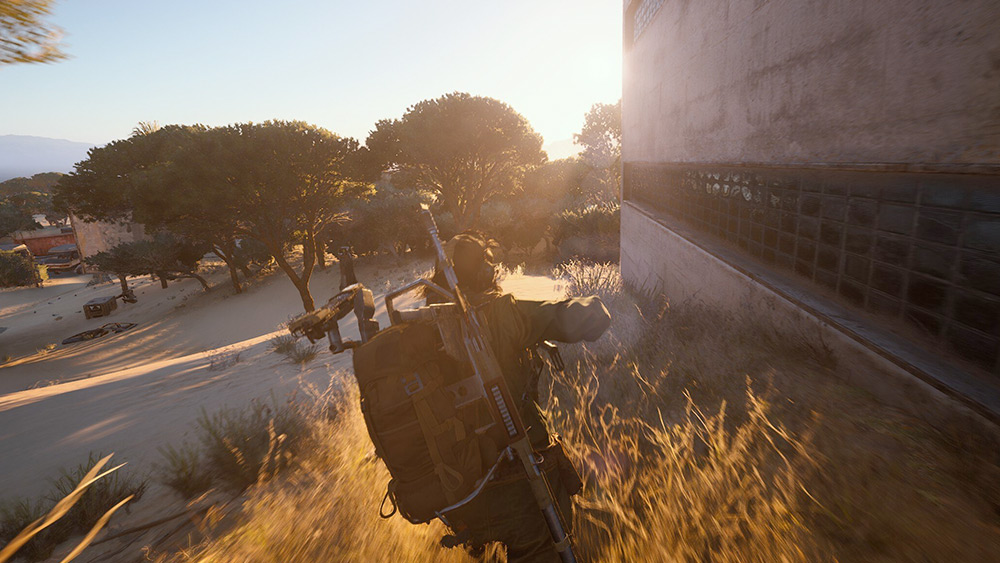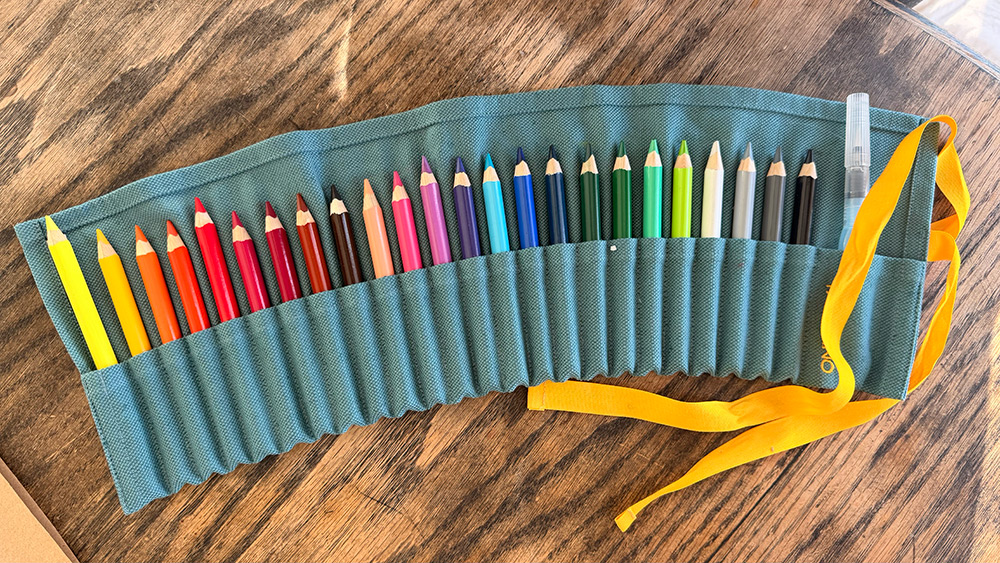- Double-wielding & music improv - Exanima 2 ✶
-
15 minutes from Exanima stream 2.
- 7-minute exercise (and stream marker tool) updates ✶
-
The workouts page is more green and glowy, with voices working in iOS. Your pocket computer phone now stays awake instead of going to sleep while you are in the middle of exercising.
The stream marker tool has placeholder titles automatically selected when created and saved after 10 seconds, nicer buttons, and subtle sound effects for button presses.
Friday, 2 January 2026
Exanima
Melee combat system aficionados, behold hither! And see a nascent series of livestreams of video game going by the name of Exanima!
Unfinished, yet accessible to play for many moons, a diminutive party keeps their mettle and bring forth bemusing medieval melee experiences, should sounds of clanking and clothing bemuse thee, as they do me, admirer of sounds of space in other audio art pieces.
Hypertexthero Exanima video list:
The beauty of Exanima is it doesn’t let one “fake it.” Being present with the physical movements, in the moment, is necessary for progress.
Further notes shall, by the grace of the gods, befall upon this page!
- Change view with middle mouse button (MMB) held while dragging mouse.
- Scroll wheel zooms in and out.
- V to place camera behind you.
- Double-click left mouse button (LMB) and hold second click for overhead chop.
- Hold Alt and click for thrusting attack.
- Click LMB just right of opponent and hold, then quickly move mouse left for a powerful swing from the right, and vice versa for the left.
- “Your character is subject to physics, your inputs must work in harmony with them.”
- “Let go of LMB at any time to perform a feint or abandon your attack to defend instead.”
- “To deliver significant damage you must land clean hits with the correct part of your weapon.”
˚ ✦ . . ˚ . . ✦
. ★⋆. ࿐࿔ . ˚ ˚ *
✦ . ✶ . ✦ ˚ ✦˚ ˚
. . ˚ . ੈ ✧̣̇ ˳ · ˖ ✦ .
Thursday, 1 January 2026
- Vinyl, tape, books, lifestream ✶
-
Vinyl record covers are nicely-sized artworks for displaying in a room.
Listening to an album you love, while taking the time to flip the record or tape, or taking the time listen to an entire album in your streaming service of choice, helps you to notice things and be present.
Recommended film: Perfect Days by Wim Wenders.
Recommended book: Bridge of Waves by W.A. Mathieu.
In 02026: Slow down, and fix things.
Slow is smooth.
Smooth is fast.
Tuesday, 30 December 2025
- GTA and Thief series in The RPS 100: Reader Edition 2025 ✶
-
Some more words from here, this time about the Grand Theft Auto (at number 38) and Thief (28) series over at Rock Paper Shotgun’s reader edition of the best 100 games of all time.
Monday, 29 December 2025
Stream marker tool
Time to slow down and take my time when traveling in digital worlds during live streams that become videos in 2026.
To help log elapsed timestamps for making YouTube video chapters, I made this stream marker tool to be used thus:
- Press Start when beginning your stream.
- Press Add Timestamp or Spacebar to add timestamps. These auto-save in 10 seconds if you don’t start typing. Click Titles to edit, press Enter to save edits.
- Press End & Save to save yyyy-mm-dd-hhmm-stream.txt with log entries with elapsed time in chronological order, and also copy the log to your clipboard so it works in an Open Broadcaster Software browser dock, which blocks file downloads. Paste the text into YouTube video descriptions for video chapters. You can also use it to log elapsed timestamps when observing anything, like your own daily stream of life.
If you find it useful you can File → Save… the tool to your computer and use it where you like, locally or on a server.
Wishing you a good 2026 ❤︎
PS. See Mindful Timer for help to take a break from screens.
˚ ✦ . . ˚ . . ✦
. ★⋆. ࿐࿔ . ˚ ˚ *
✦ . ✶ . ✦ ˚ ✦˚ ˚
. . ˚ . ੈ ✧̣̇ ˳ · ˖ ✦ .
Sunday, 28 December 2025
- Year calendar on single sheet of paper ✶
-
Here’s a live demo for 2026. There are several URL parameters, too.
Friday, 26 December 2025
- Beached things fall from the sky in Death Stranding ✶
-
In my recent stream in the Sound Space series I noticed that Beached Things (BT’s) periodically fall back down from the sky, perhaps after being sent up from the nuclear explosions of oil, in Death Stranding.
The PC version of Death Stranding 2: On The Beach should be out in February, and I’m wondering if I should continue my playthrough of the first game, given its length, with so many other good games to play.
I lost an episode or two of my streams in my move from NYC, so I’d need to redo some of the beginning, or start it again and this time play on easy difficulty for a more action-adventure feel.
- Jagged Alliance 2 in The RPS 100: Reader Edition 2025 ✶
-
JA2 and my little blurb about it made it into Rock Paper Shotgun readers’ top-100 games of all time at number 88. Yay!
Wednesday, 24 December 2025
- Making a live sky tracker for Elite: Dangerous ✶
-
Maybe the most impressive Elite: Dangerous project I’ve found thus far, by Cmdr Lysander666 (Zell Ak’inyi):
This is part of what I call “downscaled play”, whereby the commander exists in the Elite world for depth rather than breadth. I personally live on a single moon - Hypi Bra EV-P d5-78 6 a (Nahla) - and have done for several months. I do this because I fell in love with its look and feel, and I use it as a ‘monastic cell’ to do other work from. It helps me focus, keeps me immersed, and I find it productive.
…
OK, so what would happen if we just threw all the EDSM data INTO the tracker’s code and have Keplerian physics work the whole thing out for itself? Well, this would be fine IF Elite manifested perfect Keplerian physics, but I’m pretty sure it doesn’t. It simulates it. In such a case you would just be correcting the physics and the tracker code over and over again, relentlessly debugging and getting nowhere. It would be a black hole of broken JavaScript which you would have to endlessly ‘fix’.
So how do we fix it?
How did the ancient astronomers do it before Kepler? How did anyone? Regular observation. I use what I call the “Sumerian method” which is not specific to Sumer but I like the terminology. It’s record-keeping, observation and prediction refinement.
Always a moment of pure happiness when finding projects like this sky tracker for a remote moon in a simulated version of our galaxy.
Elite is an inspiring game, filling one with the urge to create things.
Tuesday, 23 December 2025
- MSFS 2024 wishlist for 2026 ✶
-
This was posted over at Stormbirds:
Things I’d like to see in this video game flight simulation:
-
Coop-enabled campaign. Something like Neofly that’s built-in and simple to jump in and play for a session or two together with friends.
-
Are you an executive in a civilian flight simulator who worries about giving us damage modelling because you don’t want to upset synergies between plane makers and other “stakeholders”? Then at least give us paint! Paintball guns on airplanes with realistic splattering paint graphics and sounds, with points, for both air and ground targets, please.
-
Tutorial showing simplest-possible editing of paint liveries, including for internal cockpit. Like we had in 2020.
-
Wednesday, 17 December 2025
Two thousand and twenty-five
2025, a year of learning and seeing new things.
Visited old friends in places I’d never been, met new ones close by, continued touching piano keys and musical dials and buttons and strings daily, recording ambient sounds, diving into an ocean of audio and through a forest of wires leading to my first published songs.
Some favorite things from our latest spin-about the sun:
Books
Fingers Pointing to the Moon by Jane English, and The Listening Book and Bridge of Waves by W.A. Mathieu were the ones I liked best this year.
I read The Creative Act by Rick Rubin for a second time. Amber’s sick of hearing me talk about it :)
Am around half-way through Thinking: Fast and Slow by Daniel Kahneman, a discussion of two modes of thinking we have, the fast, emotional, intuitive one, and the slow, analytical reasoning one, both of which can lead to silly mistakes whether you are an expert in a subject or not.
I started buying copies of my favorite books and giving them to people and it’s becoming a sort of ongoing project.
Creatures
My cat Fa has taken to meowing until I lay down so she can jump on my belly and paw (patinar) for 15 minutes, at least once per day. Slows things down, which is good. T and B have become a part of the house, temporarily at least. One learns much from observing animals, both domestic and wild, like the birds in the breeze.
Films & series
- La chimera.
- One Battle After Another.
- Watched Close Encounters of the Third Kind again and loved a scene I’d forgotten where the main character begins shovelling dirt into his own house. The artist in us versus the boring impositions and status quo of society and the world.
- Enjoyed Lynch’s The Grandmother at the Grand Rapids Film Society.
- Saw and liked both Dirty Dancing and Saturday Night Fever. How the people around affects one’s life, and the need to break away, choosing your own way.
- Am mid-way through White Lotus 3, enjoying the music and cinematography, as usual, also the story. “Spiritual malaise. Lost connection with nature, with the family. Lost connection with the spirit. What is left? The self. Identity. Chasing money, pleasure. Yeah? Everyone runs from pain toward the pleasure, and they get there only to find more pain. You cannot outrun pain. When you’re born you are like a single drop of water, flying upward, separated form the one giant consciousness. You get older, you descend back down. You die, you land back down into the water, become one with the ocean again. No more separation. No more suffering. One consciousness. Death is like a happy return, like coming home.”
People & places
- Elly, and my first music teacher Ms. M’Gaieth, left us, back to the stars 💖 🌌
- Concerts at Tip Top Deluxe Bar & Grill in Grand Rapids, MI, after walking and kicking a found tennis ball all the way there and all the way back to Yoot’s.
- Stockholm, visiting friends, fell in love with the city, particularly the gardens and greenhouses and forests and fresh food and instruments. Photographed a little, not as much as I’d have liked, but I’ll be back. Feel like going to live there a while to record an album, maybe the 2nd one.
- Helsinki, Finland, visiting friends, had my first sauna, played board games and arcade games, ate excellent food and photographed for a few hours.
- Tallinn, Estonia, after taking the ferry across the sea, for too short a time. Want to visit again.
- Back to NYC for a week to see my friend Artwo and family, old friends from youth at spring park.
- Spring Green for VVilliam the Spear Shaker and visiting friends.
- Bologna for the first time despite having lived in Italy on and off for so long. Young, old, dynamic condensed city. Still need to go through the photos. Music is the priority now.
- Rome visiting mom. She has been well this year, a relief. Thank you for your help, Beto. Bought crazy trousers for future performances. Always played music by ear, but had an opportunity for a few lessons from a classical pianist, which were very helpful. Maybe I’ll be able to play from and write musical marks on paper eventually, too, which can certainly be useful. Thank you, Paola.
- A campground on the northwest of Michigan’s big lower peninsula I forget the name of. Need to listen to the ambient sound recordings and look at the few photos.
- Reconnected with my junior high-school year history teacher, Mr. Benson, one of the best.
- Saw the Aurora Borealis from the ground for the first time with help from the X100. Photos forthcoming.
Songs ♫ & music
- Blonde Redhead’s Before, Choir Version, with Brooklyn Youth Chorus was my favorite song heard in 2025.
- Bird Hits Its Head Against The Wall and Yes It’s Me, The Goldfish! by Núria Graham.
- Requiem for My Friend album by Zbigniew Preisner.
- First live concert played in a semi-deserted natural area together with Yootsvik. A recording should materialize soon.
- E44 Stream End Piano Synth Improvisation by Hypertexthero.
- Piano Place Hold in Am by Hypertexthero.
- Fencing-Clouds from Night-Light by Peter Mergener & Michael Weisser.
- The performance by Donnie Rankin on a classic theater organ at Grand Rapids Public Museum.
Software
- Stream marker tool to set timestamps during livestreams that then become YouTube video chapters.
- Mindful timer to help remember to look away from screens regularly, or check the stove.
- 7-minute workout to stay in a basically decent shape along with healthy eating. Health is wealth.
- Began paying monthly for Signal (foundation) to help bring normality to the internet. “In a sense, I feel like Signal is just trying to bring normality to the Internet,” he said as we sat on a patch of grass near the beach. “A lot of what we’re trying to do is just square the actual technology with people’s intent.” He plucked two small feathers out of the grass, rolled them between his fingers, and planted them upright in the dirt.” Some career advice from Moxie.
- Learning Logic Pro and iMovie, maybe some Premiere Pro if needed. Notes forthcoming.
- Espanso open source text expander.
Instruments
Kept the following on throughout the day, playing and recording during breaks or whenever something comes from wherever:
- Numa Compact X SE piano and synthesizer.
- A “plastic box of buttons” named after a type of relaxing music. Notes forthcoming.
- Beastly synth named after a mythical creature, bought at Jam. Blog post nearing.
- Stratocaster and classical guitars.
- Anything that makes ambient noise, which I try to record with a stereo sound recorder.
Fast internet is available once again in Hypertexthero HQ, so expect more regular livestream projects in 2026.
Next year Linux will become much more popular.
Video games
Spent most of my video game art time with old favorites like Elite together with Yoots. Did enjoy the little I played of Arc Raiders, and some Reforger and Arma with the cooperative crew, but my appetite for shooters against human-like foes has been waning, and I’m feeling like flight and swords and magic again.
There’s a deluge of good games out there, so gotta be picky, and I’m glad game makers are making demos again, like in the days of old.
An Exanima stream will happen soon, probably before the end of the year, and maybe a couple of other new games.
Do play a free 5-minute long game called We Become What We Behold at least once a year.
Visual art, objects, etc
- The Vasa museum in Stockholm.
- The two towers of Bologna.
- Oodi library and Tove Jansson Paradise exhibition at HAM in Helsinki.
- Learning more about radios and solar panels from Yootsvik.
- New Hypertexthero calligraphic logo.
Websites
-
Music for empty rooms & Selvetica (thanks, Dan)!
-
Gemini - lots of interesting loose grammar engine conversations with a prompt beginning with: You’re <name of an author of books that have touched me on a particular subject> and we’re chatting. Then I check source links. I still see hallucinations, of course, though this happens with real people, too (it’s always good to double-check and find out for yourself), and speaking with real people, in person, is so much better and less lonely!
But this technology is a very useful tool for research. I’ve come to think of it as a powerful search engine that can read and type quickly, acting as if it is the expert of your choice. You still need to ask good questions, embrace doubt, and understand when it gets confused and leads you astray.
I think Google’ll take the biggest piece of the pie rather than “Open”AI, and that we may hear a big POP! soon.
Things to do in 2026
- Music, drawing, writing, play, cooking.
- Publish first EP and first album.
- Since it was a successful experiment in 2025, I’ll continue to wake up early and avoid consuming information in the beginning of day. I’ll avoid news especially, and instead of giving away the attention dictators and thugs crave, I’ll write my thoughts, draw something, work on a song, bring something, anything, into being, so the day isn’t sucked away by things I can’t control. This practice may become part of Sound Space.
- Keep physical paper notepads and notebooks with pencils next to them in places I spend regular amounts of time. Write notes as they come. Use color as well as graphite. Condense them into notebooks with glue later.
- Make mobile streaming and note-taking setup.
- Get sinus headaches sorted. Check if it is a tooth and fix it.
- Excercise every day. Also 20–40 minute walks, or 100 basketball shots.
- Draw and write daily, even for 5 minutes.
- Practice piano scales and harmony. Learn one classical song, one jazz song, one pop song, the more the better.
- Handwrite letters to people.
- Complete exodus from Fb/“Meta”. Make it an episode of DIY stream series.
- Work on YWAB and other photo books like the one about games.
- Set up a weekly “office hours” stream to help people.
- Give YouTube a good try, but don’t succumb to making videos like all the others. Try to keep them creative and worthwhile. Keywords: Sound, music, drawing, painting, open and random worlds.
- Make a new 1 minute stream trailer and begin making 8–10 minute-long short films.
- Set up a basic solar panel and have it power a nature cam.
- Learn to fly a real airplane, should stars line up well enough.
Wishing you a good 02026, dear visitor.
˚ ✦ . . ˚ . . ✦
. ★⋆. ࿐࿔ . ˚ ˚ *
✦ . ✶ . ✦ ˚ ✦˚ ˚
. . ˚ . ੈ ✧̣̇ ˳ · ˖ ✦ .
- What frequency really means ✶
-
A pleasure to find that MyNoise’s Dr. Ir. Stéphane Pigeon is now making videos about how sound works.
Tuesday, 16 December 2025
- Border birds ✶
-
Photographs of birds crossing borders captured with the help of open cameras and AI.
- West of Capital Knot City, Eastern Region ✶
-
This was Sound Space 5, in Kojima’s Death Stranding.
Sunday, 14 December 2025
- Hand-drawn map of the original Jagged Alliance’s Metavira ✶
-
By one of the original Jagged Alliance designers, Shaun Lyng.
Friday, 12 December 2025
- HTML tools ✶
-
Useful HTML+JavaScript tools built by Simon Willison with the help of LLMs. These remind me I need to improve my own 7-minute workout tool, where voices won’t play on iOS mobile.
Thursday, 11 December 2025
- The order of a healthy civilization ✶
-
I propose six significant levels of pace and size in the working structure of a robust and adaptable civilization. From fast to slow the levels are:
- Fashion/art
- Commerce
- Infrastructure
- Governance
- Culture
- Nature
In a durable society, each level is allowed to operate at its own pace, safely sustained by the slower levels below and kept invigorated by the livelier levels above. “Every form of civilization is a wise equilibrium between firm substructure and soaring liberty,” wrote the historian Eugen Rosenstock-Huessy. Each layer must respect the different pace of the others. If commerce, for example, is allowed by governance and culture to push nature at a commercial pace, then all-supporting natural forests, fisheries, and aquifers will be lost. If governance is changed suddenly instead of gradually, you get the catastrophic French and Russian revolutions. In the Soviet Union, governance tried to ignore the constraints of culture and nature while forcing a five-year-plan infrastructure pace on commerce and art. Thus cutting itself off from both support and innovation, it was doomed.
Make web browsers render an HTML entity glyph instead of an emoji
Web browsers and operating systems often default to rendering certain Unicode characters as colorful emojis rather than their original, monochrome text-style glyphs.
The most direct and widely supported way to request a text presentation is by appending the Unicode Variation Selector-15 (U+FE0E) character immediately after the character you want to display as text.
- How it works: This special character is an instruction to the rendering engine to use the text-style glyph variant instead of the emoji-style variant for the preceding character.
- HTML Entity: Use the HTML entity
︎or︎right after your Unicode character or entity. Examples:
| Character | Emoji (default without selector) | Text-Style Glyph (with selector) | HTML for text-style glyph |
|---|---|---|---|
| Star | ⭐ | ⭐︎ | ⭐︎ |
| Heart | ❤️ | ❤︎ | ❤︎ |
| Black Sun | ☀️ | ☀︎ | ☀︎ |
Example HTML code:
<p>Default heart: ❤ (often renders as ❤️)</p>
<p>Text-style heart: ❤︎ (tries to render as ❤︎)</p>
Note: This selector won’t work for all Unicode characters, as some characters only have an emoji presentation.
˚ ✦ . . ˚ . . ✦
. ★⋆. ࿐࿔ . ˚ ˚ *
✦ . ✶ . ✦ ˚ ✦˚ ˚
. . ˚ . ੈ ✧̣̇ ˳ · ˖ ✦ .
✶ Linked List
❦ Articles


